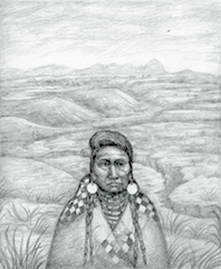|
J. William T. "Bill" Youngs, American Realities, Volume One:
Historical Episodes from Reconstruction to the Present, Chapter 1 |
"Fort Nez Percés" by John Mix Stanley, courtesy of the Wikipedia Commons
|
1. “Taming” of the West
|
SummaryAfter the Civil War many veterans stayed in the army and fought wars against the Indians in Arizona, Montana, Washington, California and throughout the West. These were the last of a series of Euro-Indian wars that had begun in Virginia and Massachusetts 250 years before. Some Americans, even some soldiers fighting these last wars, realized that the conflicts often began with the same sequence of events: whites wanted Native American land—often land that had already been recognized by treaty as reservations belonging to the Indians. Settlers and prospectors moved illegally onto the land, often killing innocent Indians, and eventually the Indians retaliated and killed whites. Enter the army on the side of the settlers, and the Native Americans were pushed onto ever smaller reservations.
This “taming” of the West happened to the Sioux in the Dakotas, the Apache in Arizona, the Modoc in northern California, the Nez Perce in the northwest, and to many other tribes throughout the West. Toward the end of the nineteenth century, however, Americans began to view the Indian wars more critically. On the brink of eliminating the last Indian resistance, Americans grew nostalgic about the “Wild West”—a great American resource symbolized by wide open spaces and free Indians. Additionally, some Americans came to see the injustice of the wars. Indians leaders, formerly adversaries, were celebrated in parades and western shows. Chief Joseph’s career illustrates that essential American alchemy whereby blacks, Hispanics, women, Indians, the poor, and other “underdogs” have articulated in times of crisis the essential meaning of American freedom, even when those with more power have seemingly forgotten those principles. |
Author reads from the Text
In 1876 General Oliver O. Howard was acting under orders to remove the Nez Perce from the Wallowa Valley. When he told Joseph that his people had given up the valley under the Treaty of 1863 and that he must move, Joseph made a soon-to-be famous argument: “Suppose a white man should come to me and say, ‘Joseph, I like your horses, and I want to buy them.’ I say to him, ‘No, my horses suit me, I will not sell them.’ Then he goes to my neighbor, and says to him, ‘Joseph has some good horses. I want to buy them but he refuses to sell.’ My neighbor answers, ‘Pay me the money, and I will sell you Joseph’s horses.’ The white man returns to me and says, ‘Joseph, I have bought your horses and you must let me have them.’ If we sold our lands to the government, this is the way they were bought.”
Joseph’s story of one man selling another man’s horses became famous years later, but in 1876 the argument failed to change the path of history. Howard told the Nez Perce that by April 1 of the following spring, they must vacate the Wallowa Valley and move to the reservation.
Joseph’s story of one man selling another man’s horses became famous years later, but in 1876 the argument failed to change the path of history. Howard told the Nez Perce that by April 1 of the following spring, they must vacate the Wallowa Valley and move to the reservation.
The Flight of the Nez Perce, 1877
View American Realities The Nez Perce in a larger map

